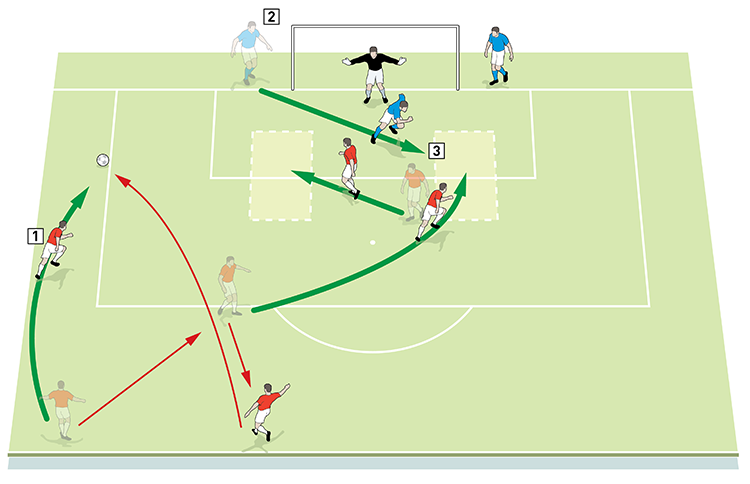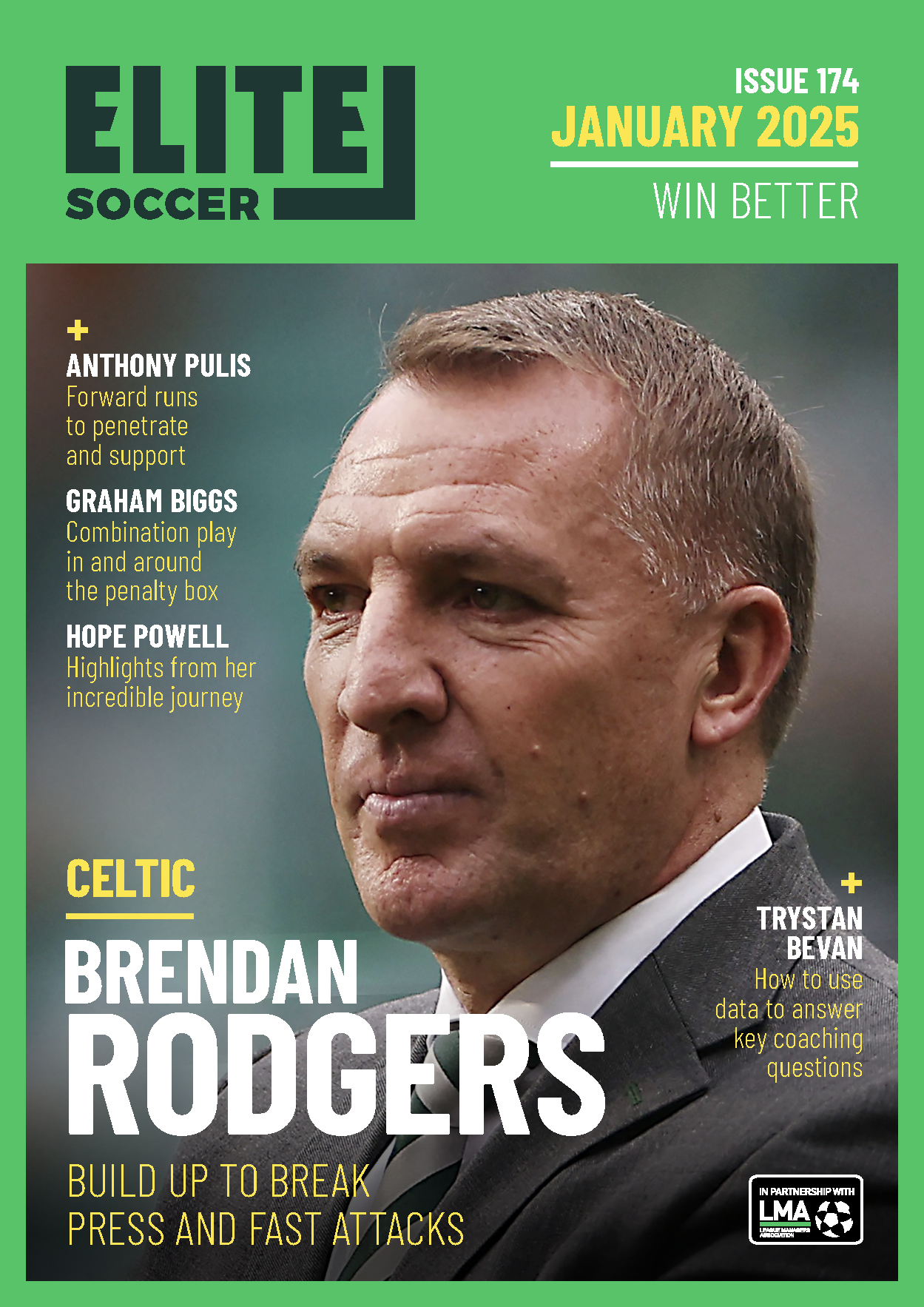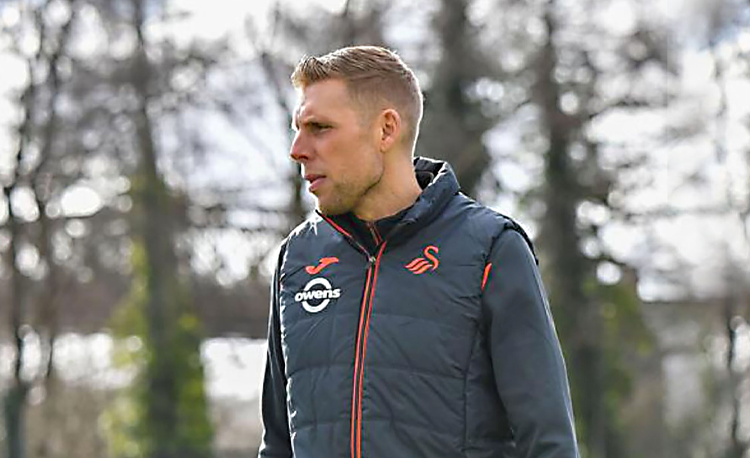You are viewing 1 of your 1 free articles
Attacking wing play
With this session we can get everyone in the team involved in thinking about how can we get the ball forwards as quickly and as efficiently as possible. We want quality and speed in all areas and an end product – ideally a goal. In order for this to happen everyone needs to understand their roles and their movements with and without the ball.
| Area | Full pitch |
| Equipment | Balls, bibs, cones and 1 goal |
| No. of Players | Full Squad |
| Session Time | Approximately 45mins: 15mins without defenders; 15mins with two defenders taking turns; 15mins with both defenders |
With this session we can get everyone in the team involved in thinking about how can we get the ball forwards as quickly and as efficiently as possible. We want quality and speed in all areas and an end product – ideally a goal. In order for this to happen everyone needs to understand their roles and their movements with and without the ball.
For me a session is about taking a small piece of the game and trying to replicate it on the training ground. This practice does exactly that and covers a multitude of areas at the same time. The beauty of it is that you can focus on any areas you feel need improving; it could be the delivery into the box, the timing of the run, the movement of the midfielders, the list is endless.
I want my teams to play quickly and get the ball out wide as soon as we can. This session is an ideal way to get my philosophy across to the players and working on it at least once a week is something I like to do.
What do I get the players to do?
Setting up on a full 11-a-side pitch, we use an area from the edge of one of the 18-yard boxes covering the rest of the field, as shown [1]. Mark out two small areas of 8x5 yards either side of the goalposts. We will ask the wide players to deliver the ball into these areas and they are where we want our strikers to be in order to meet it.
1

2. The wide player should be half turned to receive a pass from the defender, so that his first touch lets him play the ball into the striker’s feet and move forwards. The striker then combines with the midfielder
3. The midfielder feeds the wide player with a perfectly weighted pass so he doesn’t have to alter his stride when he crosses
4. The strikers should make runs into the target areas and the winger must hit one of those areas with his cross
5. The midfielder must support the attackers by moving into the area just behind them
Start with several balls in the centre circle with three to four central midfield players. They will be rotating amongst themselves as the session develops. One of them plays a ball from the centre into one of three or four defenders (who will also rotate) on the edge of the 18-yard box. A defender must get the ball down as quickly as possible and then hit a diagonal ball (pass 3 above) out to the wide player, who is half turned so that his first touch allows him to get the ball into the striker’s feet (pass 4) and move forwards.
As the ball is being played to the wide man, the two strikers are starting to make their runs, with one of them showing for the wide player. The striker who has shown for the wide man lays the ball off for the midfielder (pass 5), who after his pass into the defender has now moved up field to support the attack. The midfielder now puts a through ball into the path of the wide man (pass 6) and then looks to get to the edge of the box. Both strikers are now expected to make runs attacking the two marked areas either side of the post, while the wide player is looking to hit one of those areas.
Once players have got the rhythm going we will have attacks going down both sides of the field. To do this you need to have four strikers, four wide players, four midfield players and four central defenders to allow you to start the next attack as soon as one is ending. All of these players will be rotating.
How do I progress the session?
Once everyone is comfortable with the practice and I am satisfied with the quality we will add two defenders, one on each post, as shown [2]. The defenders will go out to defend the ball on the opposite side to where they are positioned. Only one defender will go to start with, thus forcing the wide man to make a decision – does he hit the ball hard and low or does he try to hit the second striker at the far post or cut the ball back to the incoming midfield player.
2

2. As the winger crosses, two defenders are ready to enter the pitch. Try allowing only one defender to be active to begin with
3. The defenders must defend the target area on the opposite side to their starting position so they come across the attacker, making it harder for him to control and shoot
We can also get the opposite wide man who is not crossing the ball to come inside and take up a position outside the 18-yard box, so if the ball goes over or past the second striker we can keep the pressure on the defending team.
The next step is to get both defenders to come out and defend the cross and we gradually build that up to four defenders.
What are the key things to look out for?
It is really important for the defenders to be able to get the ball down quickly from the initial pass from the midfielder in order to make a quality pass to the wide player. Also key is the movement of the midfield players and of course the timing and forward runs of the strikers. Ultimately though, the delivery of the pass into the wide man and then the cross into the attacking areas are absolutely essential to the success of the session.
How would you put this into a game situation?
As we go through the progressions by adding one defender, then two, and then we make it a back four followed by two midfield players, we can then turn this from a simple wide session into a full size 11v11 game. I would generally do this in two parts, or two sessions. In part one, I would aim to get to the point where you have two defenders defending the cross. For the second part I would start the whole exercise with two defenders and then build it up to end with an 11v11.
Related Files
Editor's Picks
Using the goalkeeper in build-up play
Pressing principles
Intensive boxes drill with goals
Penetrating the final third
Creating and finishing
My philosophy
Pressing initiation
Compact team movement
Defensive organisation
Coaches' Testimonials

Alan Pardew

Arsène Wenger

Brendan Rodgers

Carlos Carvalhal

José Mourinho

Jürgen Klopp

Pep Guardiola

Roy Hodgson

Sir Alex Ferguson

Steven Gerrard
Coaches' Testimonials

Gerald Kearney, Downtown Las Vegas Soccer Club

Paul Butler, Florida, USA

Rick Shields, Springboro, USA

Tony Green, Pierrefonds Titans, Quebec, Canada
Join the world's leading coaches and managers and discover for yourself one of the best kept secrets in coaching. No other training tool on the planet is written or read by the calibre of names you’ll find in Elite Soccer.
In a recent survey 92% of subscribers said Elite Soccer makes them more confident, 89% said it makes them a more effective coach and 91% said it makes them more inspired.
Get Monthly Inspiration
All the latest techniques and approaches
Since 2010 Elite Soccer has given subscribers exclusive insight into the training ground practices of the world’s best coaches. Published in partnership with the League Managers Association we have unparalleled access to the leading lights in the English leagues, as well as a host of international managers.
Elite Soccer exclusively features sessions written by the coaches themselves. There are no observed sessions and no sessions “in the style of”, just first-hand advice delivered direct to you from the coach.









